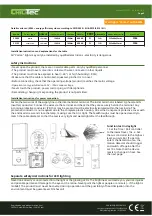
operation manual
Status: 09/2020 - Version 1.01
Page 3
Functional principle of PIR motion detectors:
The PIR sensor reacts to a change in temperature by utilizing the pyroelectricity of its receiving surface, caused by a
change in radiation flux (mainly due to heat radiation in the mid-infrared; wavelength approx. 10 µm) from people,
animals and motor vehicles in its immediate vicinity. It does not react to static differences in heat that are caused
naturally, for example by solar radiation - it can only perceive changing signals, for example when a person enters the
detection area of the sensor.
In front of the actual sensor - at a focal length distance - there is a spherical or cylindrically arched dome made of
small converging lenses made of visually whitish-cloudy plastic, which, however, is clearly transparent in the infrared.
This multiple lens collects infrared light from a corresponding number of discrete directional sectors onto the small
sensor surface. Visible light is scattered back more. Depending on the lens arrangement, the sensor sees the
surroundings as if through spread fingers, (vertical) louvre slots or the grid of a perforated plate. If an object or living
being moves with a surface temperature sufficiently higher (rarely: deeper) than the background across these
compartments from visual sectors, and is the warm, therefore lighter in the infrared area, advantageously about as
wide as a single visual sector there, so the sensor senses the chronological sequence warm-cold-warm. Because the
heat source is sometimes visible, then disappears in the visual shadow of a "finger" and reappears in the viewing slit
of the next finger gap. The temperature change at the sensor, which is somewhat delayed by the heat capacity,
causes an electrical signal that is processed and amplified in order to switch on light via a relay, for example.
In addition to transverse movement to the visible sector stripes, entering such a stripe for the first time or
approaching it sufficiently quickly (ie “getting bigger”) is also detected. Motion detectors are usually adjustable in their
sensitivity and coupled with an adjustable twilight switch.
PIR sensors only receive rays emitted by objects and do not emit any radiation themselves, which is expressed by the
term passive infrared sensor. PIR sensors react poorly when an object moves towards or away from them. This is due
to their functional principle, since the movement detection takes place on the basis of a temperature change on the
sensor surface and movements across the detection area can be better recognized due to the predominantly
transversely arranged lens area. PIR detectors can be incorrectly triggered by underfloor heating that warms up.
Reproduction only with permission from
ChiliTec GmbH, Bäckerberg 12, 38165 Lehr
EAR (WEEE): DE25841852
LUCID Packaging Act: DE5562476395648
GRS (UBA register) no .: 21003466





















